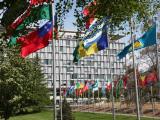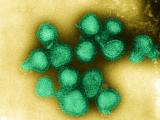Mar 6, 2007 (CIDRAP News) – A new analysis of research into the 1918 influenza pandemic, undertaken to determine whether historical accounts can illuminate planning for possible future pandemics, reveals a surprising number of enduring mysteries.
In a paper published online ahead of print by the Journal of Infectious Diseases, Dr. David Morens of the National Institute of Allergy and Infectious Diseases (NAID) and Dr. Anthony Fauci, NIAID's director, explore the relevance of the 1918 pandemic's unanswered questions to the spread of H5N1 avian influenza as well as to novel flu viruses that may emerge in the future.
Despite abundant historical accounts and almost a decade's work on the reconstituted 1918 virus, the authors say it still is not clear where the 1918 virus originated, how it produced its unique set of symptoms, why it killed so many young people yet relatively few elderly, and whether it truly occurred in a unique pattern of short, fast-moving waves.
"We must continue to examine and investigate this long-ago tragedy, allowing it to stand clearly before us as a challenge to complacency, as a modern problem with future implications, and as a grim reminder of the importance, to humanity, of continuing the fight against emerging and reemerging infectious diseases," they write.
Why the odd age distribution?
The central enigma remaining from 1918 is the "extraordinary elevation in mortality in healthy young adults," Morens said in an interview. "It's the most insoluble problem, and also the most important, because roughly half of all the people who died were in the 20- to 40-year-old age group, and at least 50 million people died around the world."
The 1918 epidemic's striking difference from both seasonal flu epidemics and other past pandemics, which have preyed mainly on the very young and the elderly, has never been fully explained. Researchers have hypothesized that an environmental factor—perhaps the contemporaneous invention of aspirin or the then-new social acceptance of cigarette smoking—made the young more vulnerable, or that the elderly retained some immunologic protection from a similar strain that might have circulated before those who were young in 1918 were born.
"There are very few good theories and none of them really stand up," said Morens, who has conducted historical research on 1918 in informal collaboration with Dr. Jeffrey Taubenberger, who recovered and sequenced the 1918 virus.
The spike in mortality, often called the "W-shaped curve" from its appearance when graphed, has modern as well as historic resonance. A World Health Organization analysis published last month revealed that 89 percent of those sickened by H5N1 avian flu, the novel flu strain considered capable of causing a pandemic if it mutates, were younger than 40.
In addition, that flu strain produces a rapid, fatal acute immune response in some of its victims—a phenomenon that to some investigators resembles the acute respiratory distress described in young victims of 1918.
In a challenge to some scholarship on 1918, Morens and Fauci question how many pandemic deaths can be ascribed to that "cytokine storm" phenomenon, setting the proportion at no more than 15% and attributing the rest to secondary bacterial infections.
"I think they may have underestimated the number of people who died directly from the virus," historian John M. Barry, author of The Great Influenza: The Epic Story of the Deadliest Plague in History, said in an interview. "In certain demographic groups deaths directly attributable to the virus were higher—certainly in army camps, for instance."
Doubts about the waves
Morens and Fauci also question the long-standing interpretation that the 1918 pandemic arrived in three short, fast-moving waves that together lasted about 9 months, a sharp difference from novel flu strains' usual pattern of reappearing annually for years.
"It is dogma that there were three waves, but if you look very closely at the data, the evidence is not very strong that there were three waves anywhere but in a few countries," Morens said.
The wave phenomenon is considered critical to understanding the 1918 pandemic, because some accounts suggest that some survivors of early outbreaks acquired immunity against later, more virulent ones—an effect that modern planners would be eager to reproduce.
"There was far less uniformity in the 1918 experience than people have assumed," agreed Dr. Martin Cetron, director of the division of global migration and quarantine at the Centers for Disease Control and Prevention. He is conducting research with University of Michigan medical historian Dr. Howard Markel on how well community protective measures such as masks and quarantine worked in 1918.
But Barry, whose 2004 book fired wide interest in the previously almost-forgotten pandemic, said that American and British epidemiologic analyses written not long afterward support both the occurrence of several waves and the development of immunity between one wave and the next. "There is better data than people realize," he said.
Is today's world better prepared?
Looking forward rather than backward, Morens and Fauci suggest that a modern pandemic resembling 1918 would not produce as much serious illness and death, because medical training, disease surveillance, public health infrastructure, and pharmaceuticals have improved so much since then. "The greatest burden of pandemic influenza would fall on those least privileged," they write.
But no matter how good modern medicine may be, a severe 1918-like pandemic would still trigger social havoc, said Dr. Michael Osterholm, director of the University of Minnesota's Center for Infectious Disease Research and Policy (CIDRAP), which publishes CIDRAP News.
"In terms of the developed world's ability to respond versus the developing world's, I think they have it almost 180 degrees backward," he said. "Under a moderate to severe pandemic, developed-world countries that rely on a constant supply of pharmaceutical and medical products would see an interruption in trade and travel. Essential products like that will not be available."
Morens DM, Fauci AS. The 1918 influenza pandemic: insights for the 21st century. J Infect Dis 2007 Apr 1;195:1018-28 [Abstract]


















